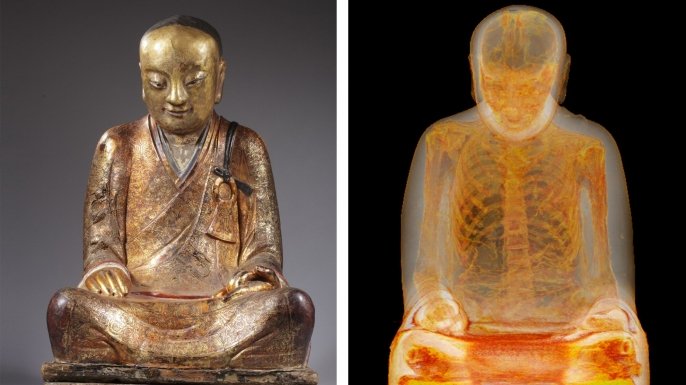The Roman chain mail
Use by Roman soldiers of the Lorica hamata , a long chainmail in bronze or steel of Celtic derivation, used for the purpose by the legionaries, was known thanks to many artistic representations. But with some exceptions, its discovery in archaeological sites is very rare, because the metal mesh corroded in the ground is almost unrecognizable. The TAC of some mysterious metal fragments found in the archaeological site of the Battle of Harzhorn in Germany (a clash between the Roman army and the Germanic tribes at the beginning of the 3rd century) revealed that it was precisely a chainmail, finally visible "live".
The Monk
Before an exhibition hosted at the Drents Museum in Holland in 2014, this statue of a Chinese monk, the only one available for research purposes in the West, was submitted to TAC. Archaeologists knew that inside there was a mummy, that of a Buddhist master named Liuquan, from the Chinese School of Meditation, who died around 1100 AD. The surprise was to see, in place of the internal organs of the monk, still in a position of meditation, fragments of texts written in Chinese characters: the proof that the religious, perhaps after a long ritual suicide, had not reached "self-mummification" " , but had instead been at least partly embalmed by others.
The Viking treasure in the Carolingian pot
This silver alloy pot, with its lid still perfectly sealed, was found together with another hundred Viking artifacts in Galloway, Scotland, in 2014, by a treasure seeker equipped with metal detectors. A first examination revealed that the find was of Carolingian manufacture, and dated back to 780-900 AD But it was the TAC to show off its treasure: pierced brooches, gold bars, ivory beads covered in gold, all findings of origin Anglo-Saxon carefully wrapped in pieces of fabric.
The medallions of the Church of Saint-Laurent
It was the synchrotron light of the European Synchrotron Radiation Facility, 100 billion times brighter than that used in hospital radiographs, to reveal the contents of a small 17th century canister, found next to a body buried in the chapel of Saint Laurent, in Grenoble (France). It was thought that inside there were some coins, instead they were found religious medals with images of Christ, of the Virgin Mary and of the Nativity, as well as writings of the Catholic liturgy in Latin. What had to be a simple analysis to enrich a museum collection, has turned into a very detailed work of archaeological reconstruction.




